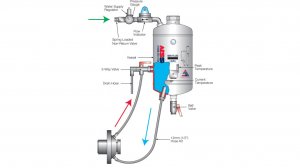In mining, tailings are piped out of the mine as slurry—a mixture of water and finely crushed rock—and deposited into tailings dams. The slurry separates over time, with solids settling to the bottom and liquid (water) remaining on top for reuse in mining operations. Mismanagement of this water content is a primary contributor to dam failures. Excessive water can saturate the embankment, leading to liquefaction-induced flow of tailings. Dam failures can result in catastrophic consequences, including loss of life, property destruction, major environmental damage and severe legal repercussions for mine officials. The challenges faced by tailings dam operations include:
- Abrasive wear: Slurries often contain sharp particles that erode critical pump components, particularly seals.
- Variable pressure conditions: Tailings dam pumps must manage fluctuating pressures that further strain sealing systems.
- High water consumption: Traditional gland packing systems require continuous water flushing for lubrication and cooling, leading to excessive water use and increased operational costs.
- Environmental risks: Leakage from seals can contaminate surrounding areas, posing environmental hazards and compliance issues.
AESSEAL’s Advanced Sealing Solutions
AESSEAL has developed mechanical seals and systems specifically designed to address these operational hurdles while enhancing durability and conserving water. A key focus is on the use of dual mechanical seals combined with an effective seal support water management system, which significantly improves performance in challenging tailings applications.
Dual Mechanical Seals
The dual mechanical seal design features two sets of sealing faces—one set sealing against the process fluid and another set sealing to the atmosphere. This configuration creates a barrier region between the faces, which helps maintain a stable fluid film crucial for effective sealing. AESSEAL’s heavy-duty double slurry seal is designed to meet the arduous requirements of slurry applications, with large ports and increased radial clearances that enable the seal to maintain stable fluid film for extended seal face life.
Seal Support Water Management System
The AESSEAL water management system range connects to the plant water line to feed the mechanical seal with a clean, cool and stable water barrier fluid. Water management systems are self-replenishing and pressurising, it is the most reliable cost-saving seal support system method for several reasons.
Increase plant uptime & Mean Time Between Failure (MTBF) – The water management system range reduces equipment downtime by increasing the MTBF of the mechanical seal.
Reduce water usage and costs – Traditional quench to drain and flush seal support methods waste huge quantities of water (up to 6.3-million litres of water per seal application per year). Water management systems reduce this water consumption to as little as 32 litres per seal application per year.
Fast return on investment (ROI) – The reduction in downtime and water / energy / operator costs means that there is a typical ROI of approximately six to nine months when installing an AESSEAL Water Management system and mechanical seal.
Environmentally friendly – The reduction in water consumption and energy means that water management systems will make the customer’s manufacturing process more environmentally friendly and reduce their carbon footprint.
Reduce operator costs – Water management systems are largely maintenance-free and can free up operator / maintenance resources for other areas of the plant.
Reduce energy usage and costs – Water management systems restrict the amount of water migrating across the seal faces into processes that require evaporation during the manufacturing process.
Impact on Operations and Environment
By integrating dual mechanical seals with a robust seal support system, AESSEAL addresses key concerns related to water consumption and environmental compliance:
- Water conservation: In regions facing water scarcity, AESSEAL’s designs reduce reliance on external water sources for cooling and lubrication.
- Cost efficiency: The extended lifespan of seals leads to fewer replacements and lower maintenance costs, contributing to overall operational savings.
- Improved compliance: Zero-leakage systems enhance compliance with stringent environmental regulations.
Edited by: Creamer Media Reporter
EMAIL THIS ARTICLE SAVE THIS ARTICLE
ARTICLE ENQUIRY
To subscribe email subscriptions@creamermedia.co.za or click here
To advertise email advertising@creamermedia.co.za or click here













